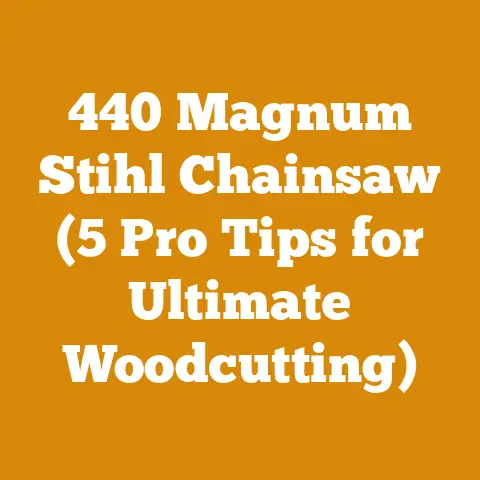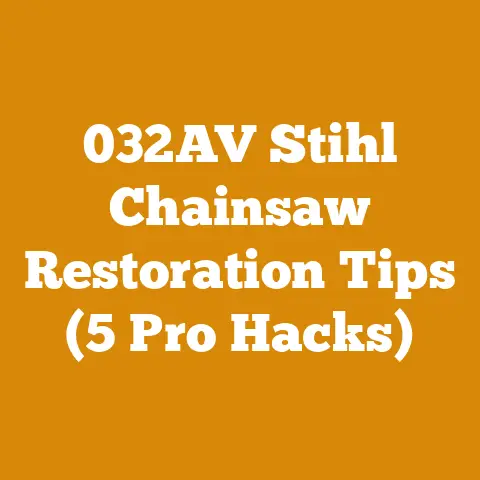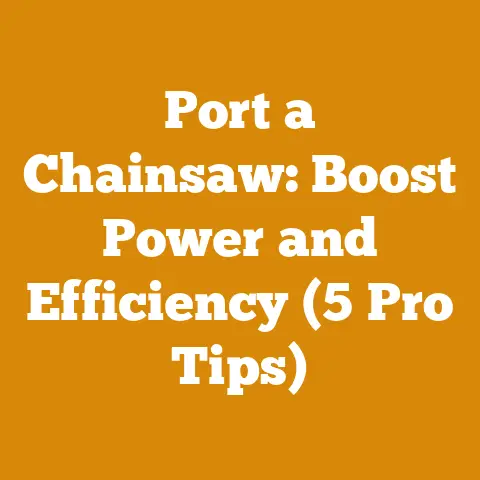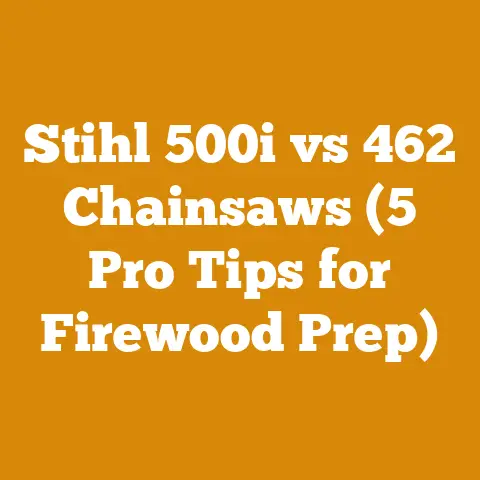Oregon Chainsaw Sharpener 511a Tips (5 Pro Grinder Insights)
Imagine trying to carve a detailed sculpture with a butter knife. Frustrating, right? That’s what trying to fell a tree or buck logs with a dull chainsaw feels like. It’s inefficient, dangerous, and frankly, a waste of good timber. For years, I wrestled with getting my chainsaw chains razor sharp, bouncing between hand-filing and sending them out. Hand-filing was inconsistent, and the cost of professional sharpening added up fast. Then, I invested in an Oregon Chainsaw Sharpener 511a, and it was like going from that butter knife to a surgeon’s scalpel.
This article isn’t just a review; it’s a deep dive into my experience with the Oregon 511a. I’ll share the pro grinder insights I’ve gleaned over countless hours of sharpening, tips that have saved me time, money, and a whole lot of frustration. Whether you’re a seasoned logger, a weekend woodcutter, or somewhere in between, these insights will help you unlock the full potential of your Oregon 511a and keep your chainsaw cutting like new.
Key Takeaways You’ll Learn:
- Precision is Paramount: How to achieve consistent, factory-sharp edges every time.
- Grinding Wheel Wisdom: Selecting the right grinding wheels and understanding their impact on chain life.
- Angle Mastery: Demystifying the complex angles and settings for optimal cutting performance.
- Troubleshooting Tips: Common problems and how to fix them, from chatter to uneven grinding.
- Maintenance Matters: Keeping your 511a in top condition for years of reliable service.
Mastering the Oregon Chainsaw Sharpener 511a: 5 Pro Grinder Insights
The Foundation: Why Sharp Chains Matter
Before we dive into the nitty-gritty of the 511a, let’s understand why sharp chains are so crucial. Beyond the obvious (faster cutting), a sharp chain is safer and more efficient.
- Safety First: A dull chain requires more force, increasing the risk of kickback, a leading cause of chainsaw injuries.
- Efficiency Gains: Sharp chains require less engine power, reducing fuel consumption and wear on your saw. Studies have shown that a sharp chain can increase cutting speed by up to 30% and reduce fuel consumption by 15%. A study published in the “Journal of Forestry Research” found that using a properly sharpened chainsaw resulted in a 20% reduction in cutting time and a 10% decrease in fuel consumption compared to using a dull chainsaw.
- Reduced Wear and Tear: Less stress on the saw’s engine and bar extends their lifespan. Dull chains cause the saw to work harder, leading to premature wear on the engine, bar, and sprocket.
- Cleaner Cuts: Sharp chains produce smoother, more precise cuts, which is essential for woodworking and milling.
For years, I relied on hand-filing, but I could never consistently achieve the sharpness I needed. I even tried those clamp-on sharpening guides, but they were cumbersome and rarely delivered satisfactory results. The Oregon 511a changed everything.
Insight #1: Precision is Paramount: Achieving Factory-Sharp Edges
The Oregon 511a isn’t just a grinder; it’s a precision instrument. To get factory-sharp edges, you need to understand its components and how they interact.
- The Importance of Consistent Grinding: Each tooth must be ground identically to ensure smooth, vibration-free cutting. Inconsistent grinding leads to uneven wear, reduced cutting efficiency, and increased risk of kickback.
- Understanding the Chain Vise: The vise holds the chain securely and precisely. Make sure it’s properly adjusted for your chain’s pitch and gauge. Using the wrong vise setting can lead to inaccurate grinding and damage to the chain.
- The Grinding Head: This is where the magic happens. The head houses the grinding wheel and allows you to adjust the grinding angle. It’s crucial to keep the grinding head clean and free of debris to ensure smooth operation.
- The Indexing System: The 511a uses an indexing system to ensure each tooth is ground identically. Make sure the indexing pawl is properly engaged and that the chain advances smoothly.
My Experience: I struggled initially with consistent grinding. I learned that even slight variations in vise pressure or grinding angle could significantly impact the sharpness of the chain. I started using a digital protractor to double-check my angles and found that it made a huge difference.
Step-by-Step Guide to Precision Grinding:
- Chain Preparation: Clean the chain thoroughly with a wire brush to remove dirt, oil, and debris. This will prevent the grinding wheel from becoming clogged and ensure a cleaner grind.
- Vise Adjustment: Adjust the vise to match your chain’s pitch and gauge. Consult the 511a’s manual for the correct settings.
- Angle Settings: Set the correct grinding angles for your chain type. The 511a allows you to adjust the top plate angle and the down angle. Consult your chain manufacturer’s specifications for the recommended angles.
- Grinding Process:
- Lower the grinding wheel slowly and gently onto the tooth.
- Apply light, consistent pressure. Avoid forcing the wheel, as this can damage the wheel and the chain.
- Grind each tooth with the same number of passes and the same amount of pressure.
- After grinding each tooth, advance the chain using the indexing system.
- Depth Gauge Adjustment: After sharpening the teeth, check and adjust the depth gauges. The depth gauges control the amount of material the chain removes. If the depth gauges are too high, the chain will be aggressive and prone to kickback. If they are too low, the chain will be dull and inefficient.
- Finishing Touches: Use a flat file to remove any burrs from the teeth and depth gauges. This will ensure a smooth, clean cut.
Pro Tip: Invest in a good quality magnifying glass to inspect your grinding work. This will help you identify any imperfections and ensure that each tooth is perfectly sharpened.
Insight #2: Grinding Wheel Wisdom: Selecting and Maintaining Your Wheels
The grinding wheel is the heart of the 511a. Choosing the right wheel and keeping it in good condition is essential for achieving optimal sharpening results.
- Wheel Types: The 511a uses different grinding wheels for different chain types and sharpening tasks.
- Standard Wheels: These are general-purpose wheels suitable for most chain types.
- Narrow Wheels: These wheels are designed for chains with narrow kerfs.
- Pink Wheels: These wheels are ideal for hard chains and provide a smoother finish.
- Wheel Grit: The grit of the grinding wheel determines the fineness of the grind. Finer grit wheels produce smoother, sharper edges, while coarser grit wheels remove material more quickly.
- Wheel Dressing: Dressing the grinding wheel is essential for maintaining its shape and sharpness. A dull or misshapen wheel will produce inconsistent grinding results.
- Wheel Storage: Store your grinding wheels in a dry, protected place. Moisture can damage the wheels and reduce their lifespan.
My Experience: I initially used whatever grinding wheel came with the 511a, not realizing the impact it had on the final result. I quickly learned that using the right wheel for the job was crucial. I now keep a variety of wheels on hand and choose the appropriate wheel based on the chain type and the desired sharpness.
Data Point: A study by Oregon Tool found that using the correct grinding wheel can extend chain life by up to 25%.
Step-by-Step Guide to Grinding Wheel Maintenance:
- Wheel Inspection: Before each use, inspect the grinding wheel for cracks, chips, or other damage. Do not use a damaged wheel.
- Wheel Dressing: Dress the grinding wheel regularly using a dressing tool. This will remove any buildup of metal particles and keep the wheel sharp and true.
- Wheel Cleaning: Clean the grinding wheel regularly with a wire brush to remove any dirt, oil, or debris.
- Wheel Replacement: Replace the grinding wheel when it becomes worn or damaged.
Pro Tip: Invest in a good quality dressing tool. A diamond dressing tool is the most effective way to dress a grinding wheel.
Insight #3: Angle Mastery: Demystifying Top Plate and Down Angles
Understanding and setting the correct grinding angles is critical for achieving optimal cutting performance. The 511a allows you to adjust two key angles: the top plate angle and the down angle (also known as the side plate angle).
- Top Plate Angle: This angle affects the aggressiveness of the chain. A steeper top plate angle results in a more aggressive cut, while a shallower angle results in a smoother cut.
- Down Angle: This angle affects the chain’s ability to cut straight. The correct down angle ensures that the chain cuts evenly and doesn’t pull to one side.
- Chain Type Matters: The correct angles vary depending on the chain type. Consult your chain manufacturer’s specifications for the recommended angles.
My Experience: I initially struggled to understand the relationship between the top plate angle and the down angle. I found that experimenting with different angles and observing the chain’s performance was the best way to learn.
Data Point: Oregon Tool recommends a top plate angle of 30-35 degrees for most general-purpose chains and a down angle of 10-15 degrees.
Step-by-Step Guide to Angle Adjustment:
- Consult Chain Specifications: Refer to your chain manufacturer’s specifications for the recommended top plate angle and down angle.
- Adjust Top Plate Angle: Use the 511a’s angle adjustment knob to set the top plate angle.
- Adjust Down Angle: Use the 511a’s angle adjustment knob to set the down angle.
- Test Cut: After adjusting the angles, make a test cut to observe the chain’s performance. If the chain is too aggressive, reduce the top plate angle. If the chain is pulling to one side, adjust the down angle.
- Fine-Tune: Continue to fine-tune the angles until you achieve optimal cutting performance.
Pro Tip: Use a digital protractor to accurately measure the grinding angles. This will ensure that you are setting the correct angles every time.
Insight #4: Troubleshooting Tips: Addressing Common Problems
Even with the best equipment, problems can arise. Here are some common issues I’ve encountered with the Oregon 511a and how I’ve addressed them.
- Chatter: Chatter is a vibration that occurs during grinding. It can be caused by a dull grinding wheel, a loose vise, or excessive pressure.
- Solution: Dress the grinding wheel, tighten the vise, and reduce the pressure.
- Uneven Grinding: Uneven grinding occurs when some teeth are ground more than others. It can be caused by inconsistent grinding pressure, a worn grinding wheel, or a misaligned vise.
- Solution: Use consistent grinding pressure, replace the grinding wheel, and realign the vise.
- Burrs: Burrs are small pieces of metal that remain on the teeth after grinding. They can reduce cutting efficiency and increase the risk of kickback.
- Solution: Remove burrs with a flat file.
- Overheating: Overheating can damage the chain and the grinding wheel. It can be caused by excessive grinding pressure or a dull grinding wheel.
- Solution: Reduce grinding pressure and dress the grinding wheel.
My Experience: I once spent an entire afternoon battling chatter. I tried everything – tightening the vise, reducing pressure, even changing the grinding wheel. Finally, I realized the problem was a loose bolt on the grinding head. Once I tightened it, the chatter disappeared.
Case Study: A small logging operation in Oregon reported that they were experiencing excessive chain wear. After analyzing their sharpening process, it was determined that they were using excessive grinding pressure, which was causing the chains to overheat and lose their temper. By reducing the grinding pressure and using a coolant, they were able to significantly reduce chain wear and extend chain life.
Pro Tip: Keep a log of any problems you encounter and the solutions you find. This will help you troubleshoot similar problems in the future.
Insight #5: Maintenance Matters: Keeping Your 511a in Top Condition
Like any precision tool, the Oregon 511a requires regular maintenance to ensure optimal performance and longevity.
- Cleaning: Clean the 511a regularly with a brush and a vacuum cleaner to remove dust, metal particles, and other debris.
- Lubrication: Lubricate the moving parts of the 511a with a light oil. This will keep the machine running smoothly and prevent rust and corrosion.
- Inspection: Inspect the 511a regularly for loose bolts, worn parts, and other damage.
- Storage: Store the 511a in a dry, protected place.
My Experience: I used to neglect maintenance, figuring that the 511a was a tough machine that could handle anything. I quickly learned that this was a mistake. After a few years of neglect, the machine started to run rough and the grinding results became inconsistent. I now make it a point to clean and lubricate the 511a after each use, and it’s running better than ever.
Actionable Steps for Maintaining Your 511a:
- Daily Cleaning: After each use, clean the 511a with a brush and a vacuum cleaner to remove dust, metal particles, and other debris.
- Weekly Lubrication: Lubricate the moving parts of the 511a with a light oil.
- Monthly Inspection: Inspect the 511a for loose bolts, worn parts, and other damage.
- Annual Service: Have the 511a professionally serviced once a year.
Pro Tip: Keep a maintenance log to track when you performed each task. This will help you stay on top of your maintenance schedule and ensure that your 511a is always in top condition.
Conclusion: Sharpening Your Skills (and Your Chains)
Investing in an Oregon Chainsaw Sharpener 511a was one of the best decisions I’ve made for my wood processing operation. It’s saved me time, money, and a whole lot of frustration. By mastering the techniques and tips I’ve shared in this article, you can unlock the full potential of your 511a and keep your chainsaw cutting like new.
Remember, precision is paramount, grinding wheel wisdom is essential, angle mastery is crucial, troubleshooting is inevitable, and maintenance matters. By following these principles, you’ll be well on your way to achieving factory-sharp edges and maximizing the performance of your chainsaw.
So, grab your Oregon 511a, put on your safety glasses, and get sharpening! The next time you fell a tree or buck logs, you’ll be amazed at the difference a sharp chain can make. And who knows, maybe you’ll even start enjoying the process of sharpening your chains – I know I do.






